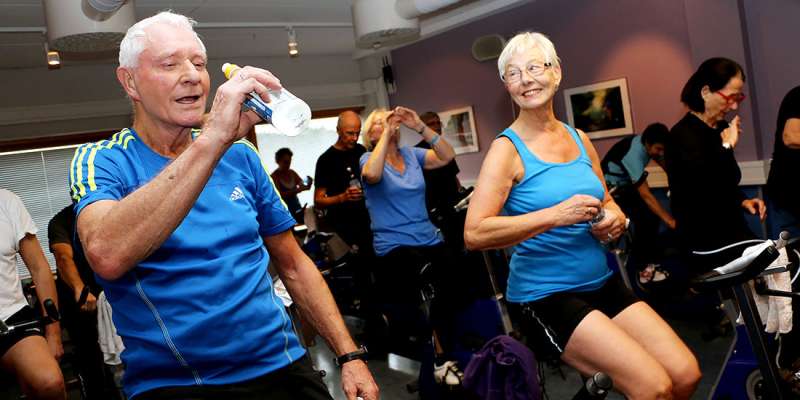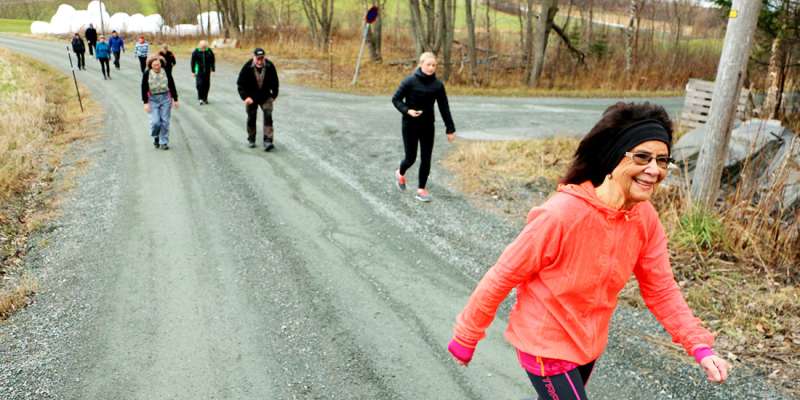Getting older adults to exercise

Generation 100, a comprehensive study from the Norwegian University of Science and Technology (NTNU) on the effects of exercise on aging, examines whether exercise actually prolongs life. But merely knowing that exercise yields big health gains doesn't mean much as long as a majority of the elderly are not active enough to achieve these benefits.
In two newly published studies, researchers at NTNU's Cardiac Exercise Research Group (CERG) has identified the kinds of exercise that older adults choose and who is most prone to dropping out of a training programme.
"The results could be important to facilitate increasing activity levels in the elderly. Information about what older adults prefer enables us to tailor exercise programmes to appeal to seniors," says Line Skarsem Reitlo. Both research articles are part of her doctoral project.
The Generation 100 study that has been underway for five years. More than 1500 participants between ages 70 and 77 were randomly assigned to one of two exercise groups or a control group. The participants in the two exercise groups undertook moderate or high intensity training sessions twice a week, mostly on their own.
"We read through a total of 70,000 exercise logs from the first year of the study. It turned out that the participants to a great degree managed to train at the prescribed intensity. This is important to know, because it indicates that older people do not need to be monitored to be able to train at high intensity," says Reitlo, a Ph.D. candidate in NTNU's Department of Circulation and Medical Imaging, which hosts CERG.
Participants were asked to fill out exercise logs documenting how long their workouts lasted, how hard they exercised, what activities they performed, where they exercised, and whether they were training alone or with someone. The article, recently published in BMC Geriatrics, includes data from the exercise logs of 618 participants in the two Generation 100 exercise groups.

Build more walking trails
Walking was the most popular form of activity in both the moderate and high-intensity training groups. In the moderate intensity group, walking represented more than half of the training that people undertook.
"Walking was the most popular activity in the high intensity group as well, but this group included more training in the form of cycling and jogging than participants in the moderate group. Achieving high intensity might have been easier with these types of activity for some participants," says Reitlo.
All the participants preferred training outdoors both in summer and in winter. Altogether, they did almost two-thirds of their workouts outside or in their own neighborhood.
"Their preference for the outdoors indicates that it's important to establish good training areas for our elders. Since walking is the most popular form of exercise, for example, it could be a good idea to create more recreation trails," says Reitlo.
Social, dancing women
"But a lot of seniors find other types of exercise attractive—and we also observed some gender differences. This suggests that we should offer different types of activities so that they meet the needs of as many elders as possible," she says.
One of the differences between older women and men is exercise intensity. Men tend to train with greater intensity, and a higher proportion of their workouts included jogging, cycling and cross-country skiing. Women were more likely to choose dance and walking as activities.
"We also found that older women exercise with others more often than older men do," Reitlo said. "Whereas women chose to train with others for almost 60 percent of the sessions, men only chose to do this 40 percent of the time."
Forgetful, unfit dropouts
The second article looks at what distinguishes participants who dropped out of the Generation 100 study. Only 15 percent of the over 1500 participants quit the programme in the first three years, which is a much lower percentage than in most previous studies with older participants.
"Dropout from exercise programmes is a challenge. But even at start-up you can pick up on which seniors may be prone to dropping out of a training programme, so that they can be followed up on and motivated a bit more," says Reitlo.
Older adults with memory loss and less education have a greater likelihood of quitting a training programme, according to the results from Generation 100. The physical fitness and activity level of the participants before the study started was also crucial.
"Individuals who were physically active for fewer than 30 minutes a day were almost twice as likely to drop out from the study within three years as those who were more physically active. Low grip strength and poor fitness are other characteristics that make elders more likely to discontinue a training programme," says Reitlo.
More information: Line Skarsem Reitlo et al, Exercise patterns in older adults instructed to follow moderate- or high-intensity exercise protocol – the generation 100 study, BMC Geriatrics (2018). DOI: 10.1186/s12877-018-0900-6


















